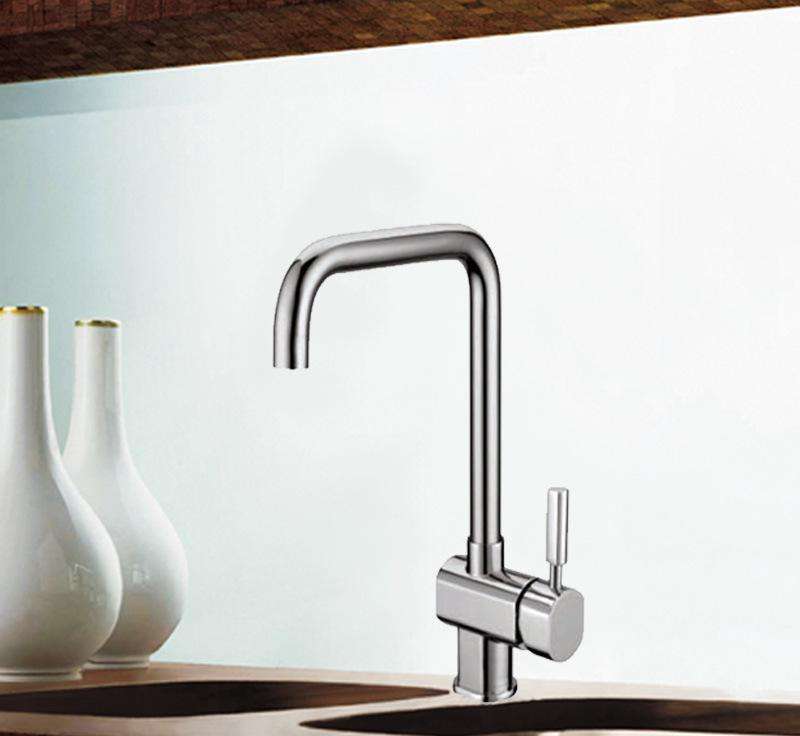Analysis of Kaiping Bathroom Faucet and Comparison of Various Faucet Raw Materials
Comparison of faucet raw materials
Stainless steel faucet
Stainless steel faucets are lead-free, acid and alkali resistant, corrosion-resistant, and do not release harmful substances, and will not pollute the source of water. Undoubtedly, it has become the focus of attention for many faucet manufacturers. It is understood that the surface of stainless steel faucets above 304 does not require electroplating. Its surface only needs to be polished to reveal its stainless steel color and maintain a silver white luster and rust. The hardness and resistance of stainless steel are more than twice that of copper products. Stainless steel is much more difficult and costly in terms of hardness, durability, solution casting, and cutting compared to copper.
Fully plastic faucet
Plastic faucets are generally made of PVC material. Its main feature is its delicacy, which is corrosion-resistant, rust free, odorless, high-pressure resistant, lightweight, and easy to construct. However, it also has the defects of simple aging and lack of robustness.
Cast iron faucet
Cast iron faucets are generally made of cast iron and iron carbon alloys with a carbon content of over 2%. This type of faucet is considered relatively old-fashioned and requires multiple rotations to release water during use. Cast iron faucets are prone to rusting, causing water pollution during transmission. In addition, its production process is outdated, the valve body is rough in manufacturing, and the valve body is simply corroded, resulting in poor effluent quality. This type of faucet, due to the simple looseness of the rotating head gasket, can easily leak water over a long period of use, resulting in wastage of the water source.

Alloy faucet
Alloy: A substance with metallic properties composed of two or more metals or non-metals. Generally obtained by melting into a uniform liquid and solidifying. According to the number of constituent elements, it can be divided into binary alloys, ternary alloys, and multicomponent alloys.
The price of alloy faucets is much lower than that of all copper faucets, and this type of faucet is simpler to produce on a larger scale. The major flaw of the alloy faucet is its lack of durability, simple appearance of cracks during long-term use, and short service life.
Ceramic faucet
As the name suggests, a ceramic faucet is a faucet made of ceramics. Compared with other faucets, ceramic faucets have the advantages of not rusting, not oxidizing, and not easily worn. The appearance of the ceramic faucet is beautiful and generous. As the outer shell is also made of ceramic products, it can better match with bathroom products, adding an artistic sense to the ceramic products and highlighting the temperament of the bathroom.
Article source: Kaiping Bathroom Faucet http://www.clasito.net
-
04-13
What is the reason for installing a bubble on a flat faucet
I don# 039; T know if we have ever thought about why there are so many bubbles in the water flowing out of the faucet? Actually, this is mainly because the faucet is required with a bubble, which can
-
04-13
What are the surface treatment processes for faucets
In recent years, with the advancement of technology, there has been a wide variety of faucet products In order to match different styles of home design, faucets have become more colorful, and there ar
-
04-13
How to maintain and maintain a flat bathroom faucet
After choosing a preferred bathroom faucet, how to use and maintain it correctly is a headache and headache for many users In fact, as long as the installation, use, and maintenance are correct and ap
-
04-13
How to determine the height and orientation of the Kaiping bathroom faucet
Strict requirements should be placed on the height of the faucet, and attention should be paid to issues such as water leakage during installation Therefore, when installing a bathroom faucet, the con
